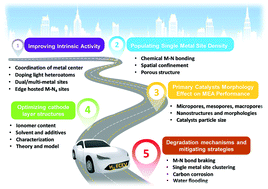Atomically dispersed metal–nitrogen–carbon catalysts for fuel cells: advances in catalyst design, electrode performance, and durability improvement
Abstract
The urgent need to address the high-cost issue of proton-exchange membrane fuel cell (PEMFC) technologies, particularly for transportation applications, drives the development of simultaneously highly active and durable platinum group metal-free (PGM-free) catalysts and electrodes. The past decade has witnessed remarkable progress in exploring PGM-free cathode catalysts for the oxygen reduction reaction (ORR) to overcome sluggish kinetics and catalyst instability in acids. Among others, scientists have identified the newly emerging atomically dispersed transition metal (M: Fe, Co, or/and Mn) and nitrogen co-doped carbon (M–N–C) catalysts as the most promising alternative to PGM catalysts. Here, we provide a comprehensive review of significant breakthroughs, remaining challenges, and perspectives regarding the M–N–C catalysts in terms of catalyst activity, stability, and membrane electrode assembly (MEA) performance. A variety of novel synthetic strategies demonstrated effectiveness in improving intrinsic activity, increasing active site density, and attaining optimal porous structures of catalysts. Rationally designing and engineering the coordination environment of single metal MNx sites and their local structures are crucial for enhancing intrinsic activity. Increasing the site density relies on the innovative strategies of restricting the migration and agglomeration of single metal sites into metallic clusters. Relevant understandings provide the correlations among the nature of active sites, nanostructures, and catalytic activity of M–N–C catalysts at the atomic scale through a combination of experimentation and theory. Current knowledge of the transferring catalytic properties of M–N–C catalysts to MEA performance is limited. Rationally designing morphologic features of M–N–C catalysts play a vital role in boosting electrode performance through exposing more accessible active sites, realizing uniform ionomer distribution, and facilitating mass/proton transports. We outline future research directions concerning the comprehensive evaluation of M–N–C catalysts in MEAs. The most considerable challenge of current M–N–C catalysts is the unsatisfied stability and rapid performance degradation in MEAs. Therefore, we further discuss practical methods and strategies to mitigate catalyst and electrode degradation, which is fundamentally essential to make M–N–C catalysts viable in PEMFC technologies.

- This article is part of the themed collection: Electrochemistry in Energy Storage and Conversion


 Please wait while we load your content...
Please wait while we load your content...
